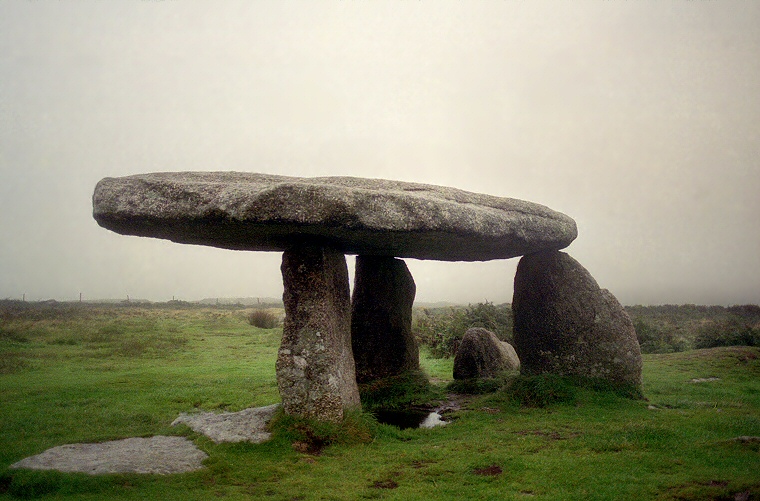
Lanyon Quoit looking northwest in late August rain 1997.
One of the
most well known and instantly recognisable prehistoric monuments in Cornwall, the iconic tripod dolmen of Lanyon Quoit is
easily accessible being signposted and standing just a few metres to the east of a minor road that runs from Trevowhan to Madron, however the stones are not quite in their original form or position having been re-erected after the chamber collapsed in the early 19th century.
The monument that greets visitors today consists of three granite upright pillars standing 1.5 metres tall which elegantly support a large slab capstone estimated to weight in the region of 15 tons that measures 5.3 metres long, 2.7 metres broad and with an average thickness of about 30 cm. Several other large slabs lay partly buried in the turf and there are a jumble of stones about 15 metres to the south which may be the remains of one or more burial cists. The whole site stands on an irregular low mound of earth and rubble no more than half a metre high which is peppered with several pits and hollows, the result of various antiquarian investigations and the no doubt vain searches for buried treasure.
To get some idea of what Lanyon Quiot may have originally looked like we have to turn to the 18th century prolific author, antiquarian and vicar of Ludgvan, William Borlase, who recorded the site in his 1754 survey of the antiquities of Cornwall and provided not only a description but a sketch and plan of the chamber more than 60 years before it fell (images shown beneath modern plan below). Borlase describes the capstone as being 5.8 metres long, 40cm thick to the east, 60cm thick to the west and being 'so high that a man can sit on horseback under it' although in reality it probably stood about 2.5 metres tall but given the depression beneath the stone, a small horse and small rider, we can perhaps forgive him a little poetic licence. Crucially he illustrates four uprights under the capstone and although he is vague about whether two or three of them support its weight he is clear that all four are aligned roughly east-west as opposed to the capstone's north-south orientation and that there are no side stones present as we would expect to find in a chambered tomb (see the Cornish sites of Chun Quoit and Trethevy Quoit for well preserved examples). Borlase suggests that the supporters had been twisted out of alignment by the weight of the capstone but it is more probable that they were actually in their original position and that the stones towards the south perhaps formed part of an ante-chamber or entrance facade, the presumed missing side stones having been removed long before his time.
Borlase made a start on excavating the interior of the chamber but abandoned the exercise after being told by the landowner that it had already been dug several years previously, apparently on account of a dream and an apparent grave pit sunk to a depth of 1.8 metres was found but which had already been rifled. Borlase took this as evidence of a primary burial but it seems more likely it was a later disturbance, clearly the site had been the target of treasure seekers for many years.
Investigating the site further Borlase realised that the chamber stood on a low mound whose dimensions he gave as about 21 metres north-south and 6 metres east-west with a disorganized collection of stones towards the southern end, he knew they represented something man-made, he just didn't know what. Today these stones are interpreted as being the damaged remains of at least one and perhaps as many as three burial cists. The battered mound itself had long been seen as the remains of a long barrow that stretched between the two groups of stones but recent interpretations see the site as more likely to have originally been two separate monuments, with the cists being set into a round barrow to the south. The chambered tomb to the north would have been set within its own surrounding barrow that probably never covered the stones but which left the top of the chamber and capstone uncovered and with an area left clear around the facade or entrance for the periodic enactment of ritual activities and the deposition of human remains within the chamber. Although the tomb has long been recognised as being of Neolithic date, the cists are undated so what the chronological relationship between the two groups of stones is remains unclear.
If Lanyon Quoit had remained in the condition that Borlase saw it we may have a better understanding of the site but unfortunately in 1815 a fierce storm caused one of the uprights (probably the one to the south in Borlase's plan) to fall bringing down the capstone and breaking one of the other supporting stones. Within a few years funds were raised by local residents to have the tomb repaired and this took place in 1824 under the supervision of a Captain Giddy, Royal Navy, 'whose zealous exertions overcame every difficulty' according to William Cotton writing just three years later. The tops of the uprights were leveled, stones were re-arranged incorrectly and a piece of the capstone was broken in the effort to re-seat it on the uprights, Cotton says Giddy should 'merit the thanks of all topographical antiquaries' for his efforts to restore the site. However I can't help feeling that if the original builders of the tomb were looking on they might have regarded the 'zealous' Captain and his labourers with their heavy machinery as a bunch of amateurs. To add insult to injury there was even the suggestion that the capstone had been replaced upside down.
Prehistoric sites often attract their fair share of stories as to their origin and purpose and the arrangement of stones at Lanyon are no exception. One local legend says that a giant's bones were found in the tomb, hence its alternative name of the 'Giant's Quoit' while another story claims King Arthur, sometimes seen as a giant himself, used the capstone as his dining table, which may account for another local name of the 'Giant's Table'.
Lanyon Quoit is located a short distance to the south of the equally iconic and enigmatic and arrangement of stones known as the Men-an-Tol.
Additional Notes:
Local expert Craig Weatherhill (1985) regards Lanyon Quiot as a Penwith Chamber Tomb, a development of the portal dolmen class of monument, other sources play it safe with just portal dolmen or chambered tomb however Clare (1982) probably sums it up best as 'too ruined to be classified'.
The monument that greets visitors today consists of three granite upright pillars standing 1.5 metres tall which elegantly support a large slab capstone estimated to weight in the region of 15 tons that measures 5.3 metres long, 2.7 metres broad and with an average thickness of about 30 cm. Several other large slabs lay partly buried in the turf and there are a jumble of stones about 15 metres to the south which may be the remains of one or more burial cists. The whole site stands on an irregular low mound of earth and rubble no more than half a metre high which is peppered with several pits and hollows, the result of various antiquarian investigations and the no doubt vain searches for buried treasure.
To get some idea of what Lanyon Quiot may have originally looked like we have to turn to the 18th century prolific author, antiquarian and vicar of Ludgvan, William Borlase, who recorded the site in his 1754 survey of the antiquities of Cornwall and provided not only a description but a sketch and plan of the chamber more than 60 years before it fell (images shown beneath modern plan below). Borlase describes the capstone as being 5.8 metres long, 40cm thick to the east, 60cm thick to the west and being 'so high that a man can sit on horseback under it' although in reality it probably stood about 2.5 metres tall but given the depression beneath the stone, a small horse and small rider, we can perhaps forgive him a little poetic licence. Crucially he illustrates four uprights under the capstone and although he is vague about whether two or three of them support its weight he is clear that all four are aligned roughly east-west as opposed to the capstone's north-south orientation and that there are no side stones present as we would expect to find in a chambered tomb (see the Cornish sites of Chun Quoit and Trethevy Quoit for well preserved examples). Borlase suggests that the supporters had been twisted out of alignment by the weight of the capstone but it is more probable that they were actually in their original position and that the stones towards the south perhaps formed part of an ante-chamber or entrance facade, the presumed missing side stones having been removed long before his time.
Borlase made a start on excavating the interior of the chamber but abandoned the exercise after being told by the landowner that it had already been dug several years previously, apparently on account of a dream and an apparent grave pit sunk to a depth of 1.8 metres was found but which had already been rifled. Borlase took this as evidence of a primary burial but it seems more likely it was a later disturbance, clearly the site had been the target of treasure seekers for many years.
Investigating the site further Borlase realised that the chamber stood on a low mound whose dimensions he gave as about 21 metres north-south and 6 metres east-west with a disorganized collection of stones towards the southern end, he knew they represented something man-made, he just didn't know what. Today these stones are interpreted as being the damaged remains of at least one and perhaps as many as three burial cists. The battered mound itself had long been seen as the remains of a long barrow that stretched between the two groups of stones but recent interpretations see the site as more likely to have originally been two separate monuments, with the cists being set into a round barrow to the south. The chambered tomb to the north would have been set within its own surrounding barrow that probably never covered the stones but which left the top of the chamber and capstone uncovered and with an area left clear around the facade or entrance for the periodic enactment of ritual activities and the deposition of human remains within the chamber. Although the tomb has long been recognised as being of Neolithic date, the cists are undated so what the chronological relationship between the two groups of stones is remains unclear.
If Lanyon Quoit had remained in the condition that Borlase saw it we may have a better understanding of the site but unfortunately in 1815 a fierce storm caused one of the uprights (probably the one to the south in Borlase's plan) to fall bringing down the capstone and breaking one of the other supporting stones. Within a few years funds were raised by local residents to have the tomb repaired and this took place in 1824 under the supervision of a Captain Giddy, Royal Navy, 'whose zealous exertions overcame every difficulty' according to William Cotton writing just three years later. The tops of the uprights were leveled, stones were re-arranged incorrectly and a piece of the capstone was broken in the effort to re-seat it on the uprights, Cotton says Giddy should 'merit the thanks of all topographical antiquaries' for his efforts to restore the site. However I can't help feeling that if the original builders of the tomb were looking on they might have regarded the 'zealous' Captain and his labourers with their heavy machinery as a bunch of amateurs. To add insult to injury there was even the suggestion that the capstone had been replaced upside down.
Prehistoric sites often attract their fair share of stories as to their origin and purpose and the arrangement of stones at Lanyon are no exception. One local legend says that a giant's bones were found in the tomb, hence its alternative name of the 'Giant's Quoit' while another story claims King Arthur, sometimes seen as a giant himself, used the capstone as his dining table, which may account for another local name of the 'Giant's Table'.
Lanyon Quoit is located a short distance to the south of the equally iconic and enigmatic and arrangement of stones known as the Men-an-Tol.
Additional Notes:
Local expert Craig Weatherhill (1985) regards Lanyon Quiot as a Penwith Chamber Tomb, a development of the portal dolmen class of monument, other sources play it safe with just portal dolmen or chambered tomb however Clare (1982) probably sums it up best as 'too ruined to be classified'.
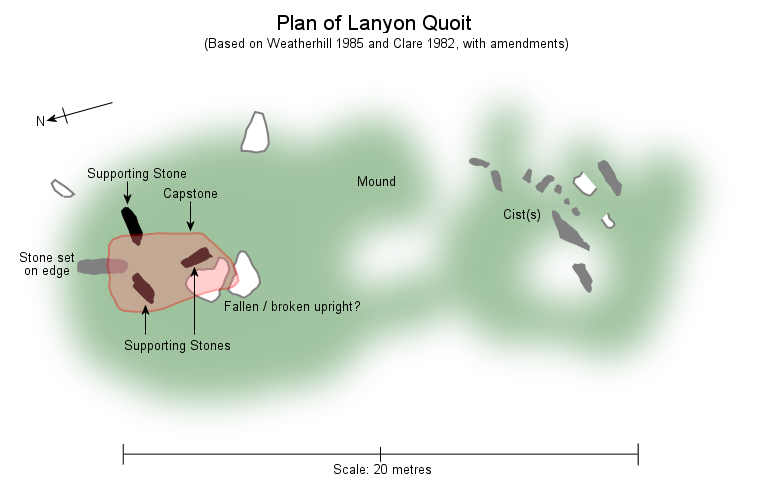
Although it looks like a simple monument on first glace, the chambered tomb of Lanyon Quoit is part of a quite complex site whose understanding is made more difficult by the damage it has sustained over the years. In the plan above the familiar standing stones are to the left, the possible cists to the right. The three uprights supporting the capstone are shown in black, the capstone in red, fallen stones in white and all other stones as gray. The approximate remaining extent of the mound is shown shaded green.
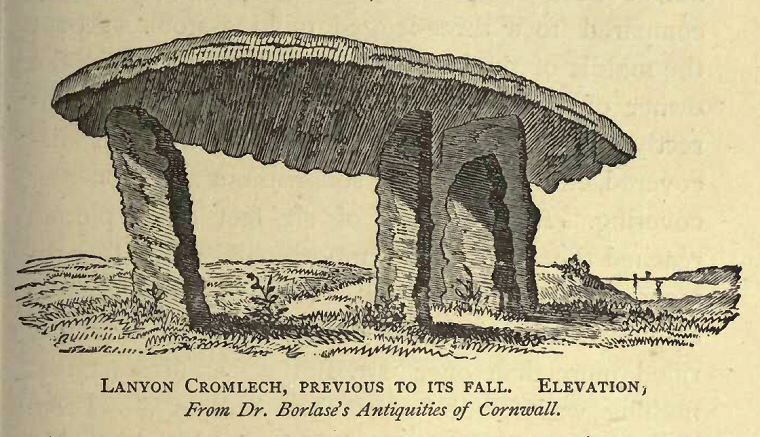
Lanyon Quoit in the mid 18th century many years before the capstone fell, illustrated by William Borlase and reproduced in his great-great grandson William Copeland Borlase's book Naenia Cornubiae published in 1872. Borlase shows three tall uprights with one shorter stone, although he describes the two stones in the foreground as 'the chief supporters'. It is believed that it was the broad upright at the rear of the chamber (to the south) that fell inwards in 1815 causing the collapse of the tomb.
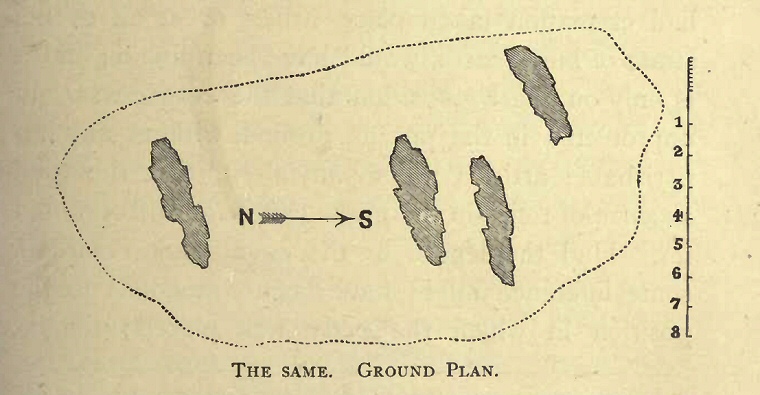
Drawing from the same page of Borlase and to the same alignment as the image above. Borlase's plan differs from the modern reconstruction and if his drawing is accurate, shows that the four uprights were all aligned with their long edges in the same roughly east-west orientation. His scale bar totaling 9 feet is equal to 2.7 metres.
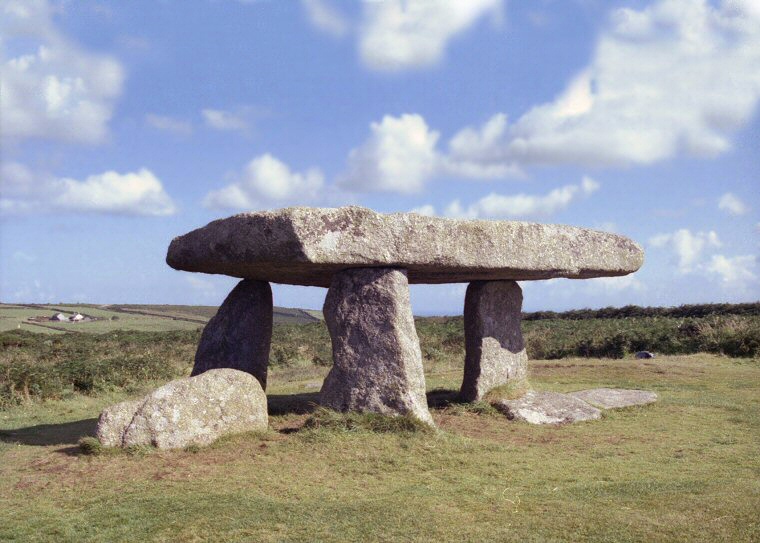
Lanyon Quoit looking southwest in 1999. It's not clear where the stone set in the ground on it's edge to the left of the picture originally came from, I suspect it may be a broken part of the capstone.
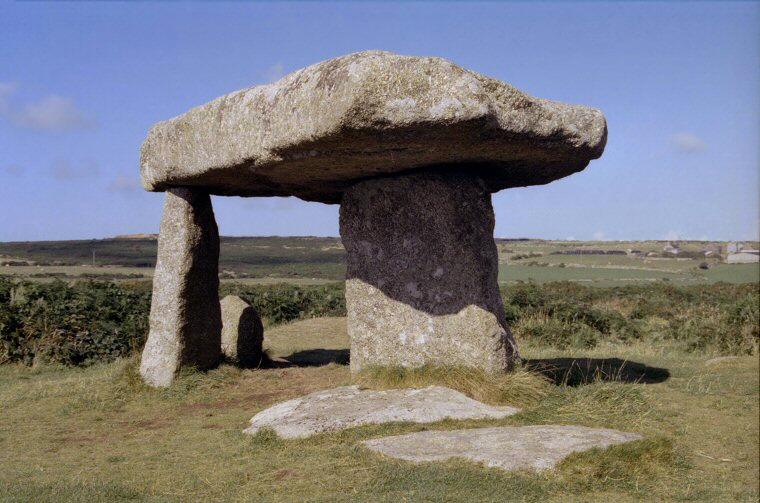
Lanyon Quoit looking northeast. The two slabs in the foreground look like they may fit together, they may have been the supporting upright that was broken during the fall of the capstone in 1815.
Site Visits / Photographs:
August 1997, August 1999.
References:
Blight, J. T. 1861. A week at The Lands End. London: Longman, Green, Roberts.
Borlase, W. 1754. Observations on the Antiquities, Historical and Monumental of the County of Cornwall. Oxford:
Borlase, W. C. 1872. Naenia Cornubiae - A Descriptive Essay. London: Longmans, Green, Reader and Dyer.
Clare, T. 1982. Archaeological Sites of Devon and Cornwall. Ashbourne: Moorland Publishing.
Cope, J. 1998. The Modern Antiquarian. A Pre-Millennial Odyssey through Megalithic Britain. London: Thorsons.
Corio, D. and Corio, L. N. 2003. Megaliths. The Ancient Stone Monuments of England and Wales. London: Cape.
Cotton, W. 1827. Illustrations of Stone Circles, Cromlechs ... in the West of Cornwall. London: James Moyes.
Dyer, J. 1981. The Penguin Guide to Prehistoric England and Wales. London: Penguin Books Ltd.
Gilbert, C. 1817. An Historical Survey of the County of Cornwall. London: Longman.
Grinsell, L. V. 1936. The Ancient Burial Mounds of England. London: Methuen.
Halliwell, J. O. 1861. Rambles in Western Cornwall. London: John Russell Smith.
Hawkes, J. 1986. The Shell Guide to British Archaeology. London: Michael Joseph Ltd.
Lukis, W. 1875. On the class of Rude Stone Monuments... Cromlechs... Ripon:.
Weatherhill, C. 1985. Cornovia. Ancient Sites of Cornwall & Scilly. Penzance: Alison Hodge.
Historic England Research Records Hob Uid: 424288.
National Monument Record Number: SW 43 SW 41.
County Number: Cornwall CO 3.
National Trust HBSMR Number: 91350.
Scheduled Monument Number: 1006745.